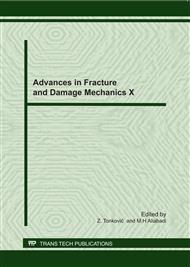p.521
p.525
p.529
p.533
p.537
p.541
p.545
p.549
p.553
Finite Element Simulation on Failure Assessment of Toughened Epoxy Adhesives
Abstract:
The prediction of the strength of adhesively bonded joints has been investigated using a variety of failure criteria such as maximum stress or strain, and fracture mechanics approaches. Fracture mechanics approaches based on the critical strain energy release rate, for crack propagation are applicable to highly cross-linked structural adhesives and have the advantage of avoiding the explicit consideration of the bi-material singularities inherent in adhesive joints. In the present work, the finite-element simulation of such adhesive joint has been performed and the R-curves of two different rubber-toughened epoxy adhesives were measured using double cantilever beam (DCB) specimens. The FE results are applied to be compared with the experimental results which were reported in the literature.
Info:
Periodical:
Pages:
537-540
Citation:
Online since:
September 2011
Authors:
Keywords:
Price:
Сopyright:
© 2012 Trans Tech Publications Ltd. All Rights Reserved
Share:
Citation:


